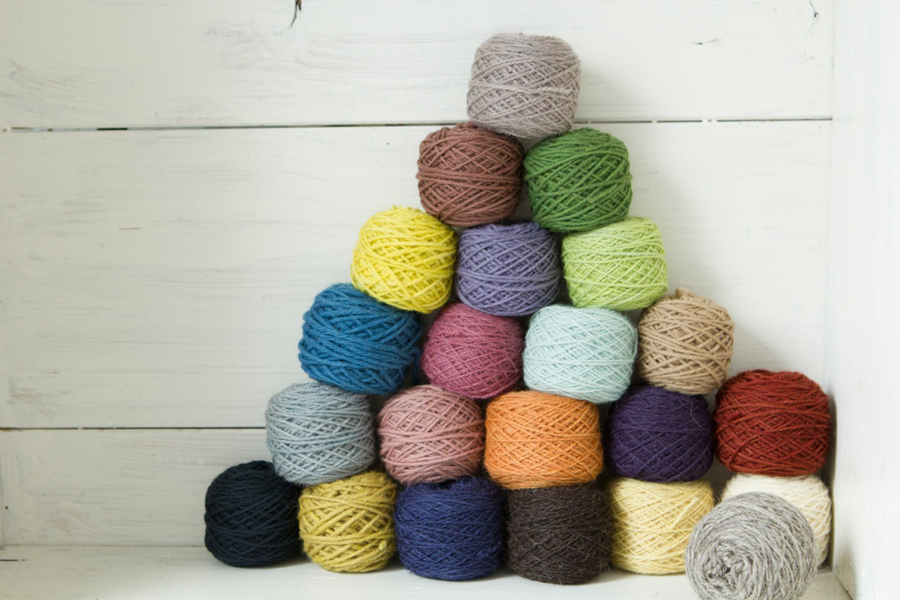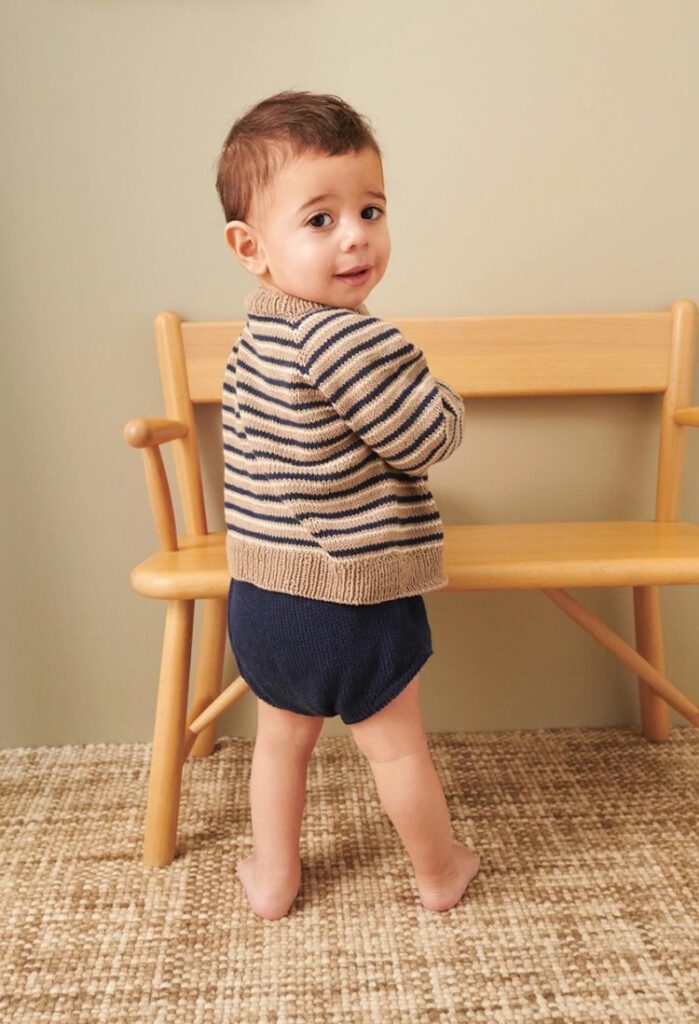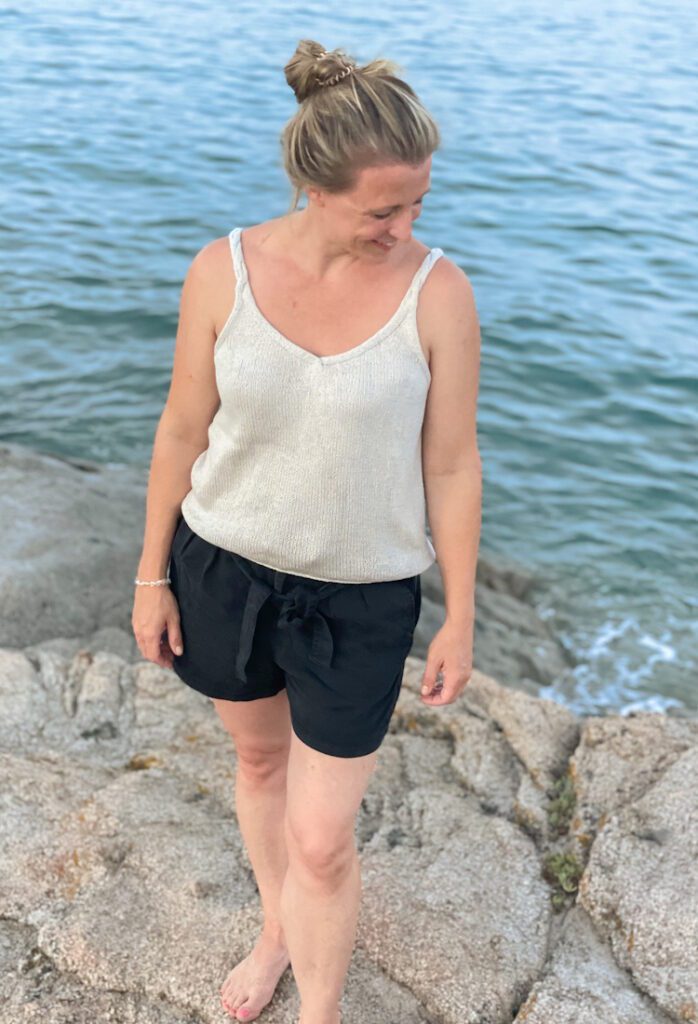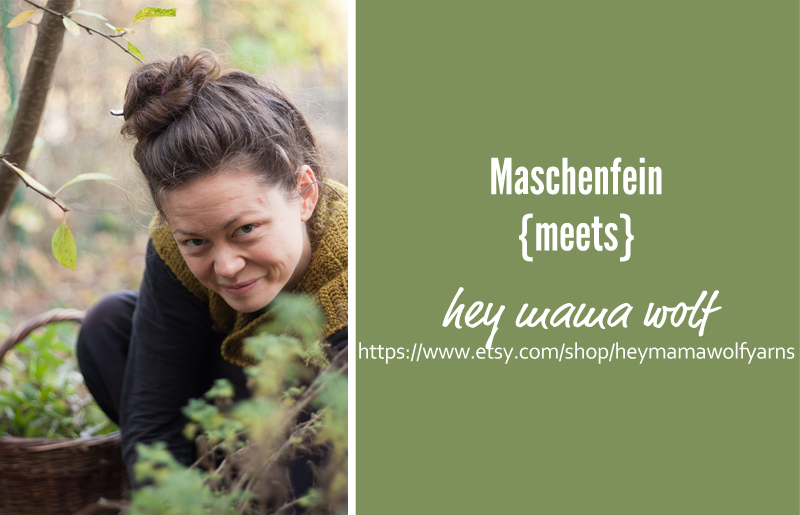Today I would like to introduce you to Jule from Hey Mama Wolf, who recently started offering her hand-dyed yarns in her Etsy store Hey Mama Wolf Yarns. Her yarns are very special. They are made from the wool of sheep that graze the heaths, dikes and meadows of eastern and northern Germany. After the wool is spun in the Czech Republic, Jule hand-dyes it with plant dyes and plant dye extracts. For the most part, she uses self-collected or organically grown plant material.
I've been following Jule on Instagram for a long time and have been eagerly awaiting the opening of her store. Now the time has come and I wanted to learn more about how she came to what she does today. Reading her answers got me so excited that I would love to be there dyeing one day. It is an incredibly exciting field and I hope you now have fun diving into this world.
Your journey to Hey Mama Wolf Yarns actually starts with knitting, because in addition to your hand-dyed yarn company, you're also passionate about knitting. How did you get into knitting in the first place?
I made my first stitches when I was about 10 years old. My great aunt took me aside and said - "Child, you must learn to knit." And from then on I knitted mainly for my dolls. I learned to knit properly later with Bella, a Russian immigrant, in Tel Aviv at Shenkar College. Bella can do everything and taught us a lot. With her I learned to knit socks almost at university level. Back in Berlin, I met Tanja Lay from handmade Berlin, who was just opening her store. She was looking for someone to teach knitting classes. There and now at Wollen Berlin I offer knitting courses. I would say through the classes and the wonderful participants (3 men in 8 years!) I actually learned the most about knitting.
So knitting was always omnipresent during your studies in textile and surface design?
I lived across the street from Fadeninsel in Berlin-Kreuzberg at the beginning of my student days and was a regular customer there (much later, I even worked there in sales). I knitted mainly in the art history lectures. It was stuffy and dark, the projector hummed and knitting kept me awake.
In the last year of my studies, we were asked in the business management seminar to write a kind of business plan for our own company. I didn't know what it should look like, my business. But I knew very clearly it had to include knitting in one way or another. The prof, however, didn't think it was that clear.
How did it come to the foundation of your label Hey Mama Wolf? And how did it come about that knitting in the broadest sense actually became your profession?
After graduation, I promptly got pregnant. I had a small blog where I mainly offered my courses. And about it found me again and again small fashion designers and costume designers. When my daughter was only 4 months old, I started making model clothes. It was wonderful to integrate into everyday life with an infant. Either I executed a design or I designed the knits to match the collection. One of my most famous customers was Sarah Illenberger. In the beginning, I still made the designs myself. Gradually, the order situation became so good that I no longer had the time to do this. Some knitters did it for me with bravura. Among my most prominent knits are the ones that were featured in the movies "Cloud Atlas" and "The Medicus". That was a wonderful and exciting job that I loved doing.
Was it then a logical step for you to move from hand-knitting to spinning and dyeing, and to produce your own material, so to speak?
I became more and more involved in the technique of knitting and crochet. I wanted to go in depth and so I came to learn to spin and learn more about the different natural materials. For weeks I immersed myself in books about wool as a material. It is fascinating, I can only say. With a friend I started to plan a children's fashion label for knitwear. The wool used should be produced regionally and ecologically. If possible in Germany. We didn't find anything that met our requirements and could be used for children's fashion. Through this search I came to the idea to produce this wool myself.
The spinning is one thing. You also dye your fibers yourself. How did that come about?
About the dyeing I had not thought at all until then. Two friends independently approached me about whether I knew about vegetable dyes. Once I started dyeing, I couldn't stop and it was good that I was so familiar with fiber at this point. It's amazing how these radiant colors come out of sometimes very unspectacular looking plants at first glance. I also knew a lot about herbs, trees and flowers beforehand, so dyeing with plants was a step in which everything came together.
Can you tell us a little more about the vegetable colors? What are their advantages over chemical colors?
Plant colors are more profound than chemical colors derived from mineral oil. They change much more with the changing light conditions. They are also more unpredictable. The location of the plant, the soil conditions and the weather in the year have an influence on the dyeing result. So does the water used, the weather conditions and the pots in which the dyeing is done. This makes it exciting and so no result can be the same and each dyer has her signature.
How exactly does dyeing with plants work? Can you tell us a little more about how it works?
What is particularly exciting when working with natural materials is that the result always depends on many, many factors. With the wool as with the plants. How was the weather in the year and on the day, how old is plant, at what time of year is collected, how is the soil condition, etc. pp. The same applies to the dyeing itself. Do I use dried or fresh material, is it an enamel or a copper pot, do I dye cold and with a lot of time or hot, how is the weather on the dyeing day, etc. pp.
First, the plant material is harvested or collected, and then soaked in water. Flowers are sometimes just doused with hot water, but tree bark can take a few days. Usually the whole thing is still boiled and then strained through a cloth. The wool must usually also be prepared for dyeing, the so-called mordanting. The material to be dyed (the dyeing material) is brought to boiling point with the mordant and then kept like this for about 1 hour. The mordanted and rinsed dyeing material is later added to the cooled liquor and is heated up again to a certain point. After a while drain and dry and ready is the dyed wool.
A concrete example: The organic food store around the corner from me often has carrot greens to give away. I soak it overnight and boil it the next day. Meanwhile, I pickle the wool. I strain the carrot green liquor through a gauze cloth, rinse the wool and wait until the liquor has a maximum temperature of 40 °C again. Then I add the wool and heat the whole thing again.
In the next Makerist magazine, coming out in January, I will show step by step how to dye with black beans.
Where do you get the wool for dyeing?
The wool comes from German farms. For the most part, these are micro sheep farms. It would not be worth it for these shepherds to get certified. My second yarn is a certified organic wool. My goal is to sooner or later be able to offer another organic yarn that comes from farms that I have personally selected. That way I could clearly communicate to my customers where their knitting yarn comes from.
You deliberately chose wool from German sheep. Why?
Just as I like to tell the story of how a particular color came to be, what's important to me about wool is primarily what it can tell me, not whether it's particularly soft. I usually like the stronger wools better. They have a different stand and pick up the colors quite differently because they have a higher sheen. And so my one yarn is quite a sturdy one. The North German sheep simply need this wool to tolerate the climate as well. The organic yarn is a little softer, but still with character.
The things that grow around us are usually what do us good. And so I can't understand why we buy wool that has to be sent three times around the globe to reach us. The sheep stand in Australia, are partly kept miserably. The wool is then shipped to Asia to be cleaned, spun and dyed. The wool is then often knotted somewhere in Europe, so that it can be sold at the lowest possible prices in our pockets. What a waste of fossil energy! When I buy wool, I like to buy wool that has been produced where I buy it. Then I know exactly, it comes perhaps a long distance to me, but has not made a world trip before.

What are your plans for the future of Hey Mama Wolf?
Soon my family and I will move out to the village in Brandenburg, there I have space for a proper workshop. I would like to grow my dye plants myself and have the possibility to return the used plant material to the cycle via compost. That is only possible to a limited extent here in Berlin. I would like to be able to go outside in the fall and collect fallen branches and acorns for dyeing after a storm.
We want to set the highest ecological standards in all parts of our company. Be it the paper and printing inks of the manuals, the packaging material and the banderoles for the columns, mechanical scales instead of battery-powered ones, a green webhost or electricity from renewable sources. It doesn't all work out right away, but we do our best to get to the best result. We are open to new ideas regarding the sustainability of our company.
Thank you very much for your answers, Jule.
You will find Jule...
... on her blog
... on Instagram
... in her Etsy store
All photos were provided to me for this article by Hey Mama Wolf.
 In the mood for spring? Here you can find spring yarns
In the mood for spring? Here you can find spring yarns  Neu - Sandnes 2407 - Sommerbaby
Neu - Sandnes 2407 - Sommerbaby  Neu bei uns - Lankava
Neu bei uns - Lankava  Hier findest du alle Maschenfein-Anleitungen
Hier findest du alle Maschenfein-Anleitungen








Thank you for your comment!
Please be patient until it appears on the site, as we approve all comments manually.